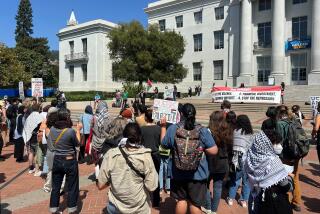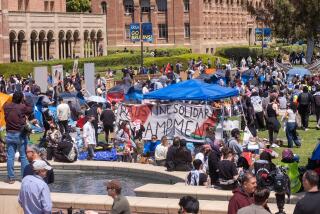Cal State’s 1st Dorm Offers Students a Touch of Class
- Share via
FOR RENT: Modern apartment in prestige university location. Luxury baths; kitchens w/ dishwasher and microwave oven. New furniture and rugs throughout. Six people share three bedrooms, two baths, kitchen, dining room and living room with picture window facing atrium; $225 per month per person, plus about $15 a month utilities.
Such would be the description if Cal State Fullerton were soliciting tenants for its new 386-student dormitory, scheduled to open Jan. 25.
The gleaming white, four-story facility is not only new, it’s historic: It is the first on-campus residence in the 28-year history of the California State University branch. Its opening is a dream come true for Cal State Fullerton President Jewel Plummer Cobb.
“We are very pleased and excited,” she said Thursday. Cobb made on-campus housing a prime goal of her presidency. Her efforts spurred the state Legislature into authorizing a bond issue paying for the $7.5-million residential complex.
Long tagged a “commuter college,” Cal State Fullerton, with more than 24,000 students, is the largest four-year university in Orange County. Thousands of its students--no exact total is available--live in commercial rental units in Fullerton and other nearby communities. But no student has ever had the luxury previously of being able to live on campus.
As Cobb noted, rentals in this expensive county are often “extremely high.” So the new on-campus dorm could be considered somewhat of a bargain at $225 per month per student, considering all the extras. Rent includes full furnishings in the rooms, plus use of a central typing room, computer room, weight room, multipurpose room and even a snack bar.
Outside, there are communal barbecue grills and picnic tables, as well as basketball and volleyball courts at the housing complex. A high-rise attached garage provides covered parking for their cars.
Ron Butler, a university official who will live in the new dorm as a sort of overall superintendent, Thursday showed off the nearly finished residences.
While he said the rates students will pay are comparable to commercial rentals in the area, Butler added that dormitory tenants will get a lot for their money. “I think they’re going to like the microwave ovens, and I’m sure they’re going to like these dishwashers,” he said as he gave a tour of a kitchen in one of the suites.
Male and female students will live in the same buildings but not in the same suites. All residents of a six-student suite must be of the same sex.
Each suite has three bedrooms, with two students sharing each bedroom. Each unit has two large, well-equipped baths; a kitchen; dining area and living room that the six residents share.
There is no cafeteria in the housing complex, but students can buy on-campus meal plans for $480 a semester. It is a chit system that allows students to “buy” two meals a day at any of five on-campus eating places.
As of Thursday, 335 of the 386 available dormitory spaces had been rented. “The rest will be full by Jan. 25,” predicted Butler, who is the campus assistant director of housing service and residence life.
The main reason the facility is not already booked full is that the dormitory is opening in the middle of the school year. “By next fall, we’ll have a long waiting line,” he said. “In fact, we’ve already received more than 400 inquiries for next fall.”
The first-time dorm residents may be luckier than they realize because they are getting in when the demand is still low. Moreover, they are beating what national educational officials call “a university housing crunch.” At places such as UCLA and the University of California, Berkeley, on-campus housing is so scarce that lotteries are held annually for the few available rooms.
For Cal State Fullerton students, a university survey last March determined that the average cost for a room in a boarding house in the area was $290 a month, university officials said. The average cost for a studio apartment was $537; for a one-bedroom apartment, $595; for a two-bedroom apartment, $687, and for a three-bedroom apartment, $850.
An average three-bedroom apartment, divided by six students, therefore could be cheaper than the $225 charged by the on-campus dorm. The catch, however, is that apartment managers hesitate to rent one unit to six students.
Another big advantage to on-campus dorms, university officials said, is fitting students into the overall college experience.
“Dormitories provide a residential education that enriches the academic experience of every student who is fortunate to live on campus,” President Cobb said. “Not only will the students have the opportunity to work more conveniently outside of the classroom--whether in the laboratory, studio, rehearsal hall or library--but they will be able to participate more fully in the university’s extracurricular activities.
“Research on residential living shows that students living on campus have better grades, more opportunities for closer interaction with faculty members and more positive and lasting memories of their university experience.
“Cal State Fullerton students in residence halls have an added bonus because the housing vacancy rate in Orange County is less than 2%, which means that rents in the area are extremely high--when such housing (is at all) available. Added to this is that more than 4,000 of our students must drive for an hour or more each way on crowded freeways to get to classes.”
The modern-looking, stucco-finish structure is actually divided into three distinct areas. They will be called Cypress House, Valencia House and Sycamore House.
Butler said, “We at first were thinking about naming the houses for beach areas, but we decided it would be more appropriate to name them for trees, since we’re located by the Fullerton Arboretum.”
The arboretum, a scenic area of rare trees, plants and flowers, is immediately to the west of the new housing complex. The dorms are at the northeast corner of the campus, near the intersection of Yorba Linda Boulevard and the Orange Freeway.
Although the living area is near the freeway, there is no freeway noise audible inside the suites, even those closest to the freeway, Butler said, because “the walls are thick, and we have double-paned windows.”
While the Legislature provided the financing mechanism for the project, no tax dollars are involved. The money comes from a bond issue that will be fully repaid by the rental money paid by the students.
“We think this housing is great for the campus,” Butler said. “There’s already talk about . . . another one being built sometime in the future.”
More to Read
Sign up for Essential California
The most important California stories and recommendations in your inbox every morning.
You may occasionally receive promotional content from the Los Angeles Times.






